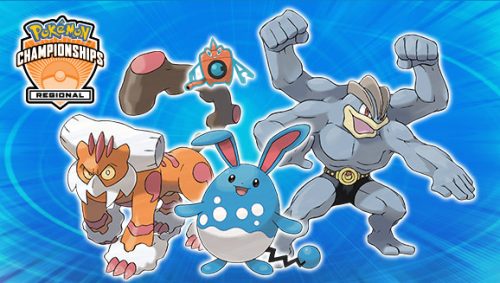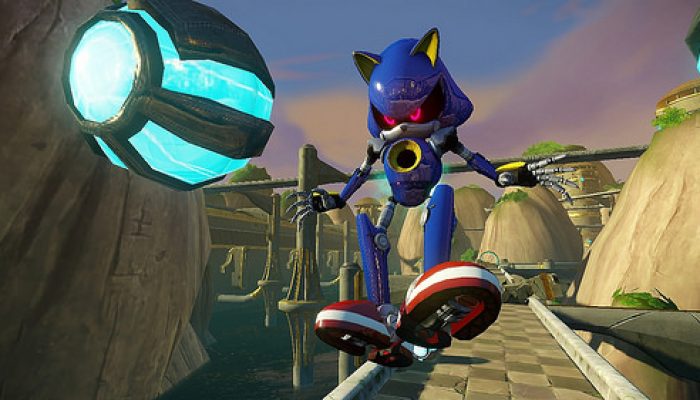 Swiss rounds will be single games instead of best-of-three matches.
Swiss rounds will be single games instead of best-of-three matches.
☆ NintendObs Weekly – Monday, September 21, 2015 – Sunday, September 27, 2015.

Will It Be an Autumn Regionals to Remember?
The Autumn Video Game Regional Championships typically present a different challenge from the Regional Championships that take place later in the season. While the Winter Regional Championships usually come with a change in rules, the Autumn Regional Championships use the same format as the previous season’s Pokémon World Championships. Instead of trying to figure out which teams and Pokémon are most effective in a new format, players will need to react to last season’s tournaments, and pick the Pokémon best suited to come on top of the trends leaving Boston. Players will also need to adjust their strategies for the single-game Swiss rounds at the Regional Championships, which present a different challenge from the best-of-three Swiss rounds at the Pokémon US Nationals and World Championships.
Many Trainers look to the teams that were most successful at the previous Pokémon World Championships for guidance until the format changes, which ordinarily occurs at the beginning of the calendar year. Competitors should be prepared to face off against teams virtually identical to those that did well at the World Championships, as well as against teams that have taken the key strategies from teams in Boston and added their own twists. Last year, it was the Trick Room teams featuring Gothitelle and Mega Mawile that dominated play after the World Championships. With this year’s Autumn Regionals approaching, players will again be looking to find that magical combination of Pokémon to carry them to a Regional Championship victory.
Straight Outta Boston
As we reported after the Pokémon World Championships, there is a clearly defined group of top Pokémon that Trainers can base most of their Autumn Regional preparation around. Landorus Therian Forme, Amoonguss, Heatran, Mega Kangaskhan, Cresselia, Thundurus, and Aegislash were clear favorites at the World Championships, and they will almost certainly continue to be the most popular Pokémon in the field. Trainers will be faced with a difficult dilemma: Is it better to use the Pokémon everyone is expecting and to try to win with them by maximizing power, or is it best to change things up and have more surprises opponents aren’t prepared for?
The greatest strength of the top Pokémon in this format is that they have a leg up in general power over their peers. They are the strongest because they have the best combination of stats, types, and move options available. If opposing Trainers choose to build their teams to have matchup advantages against the top Pokémon, they must give up some power on their own team by choosing Pokémon that are slightly weaker overall in exchange for skills tailored to taking out the toughest Pokémon. That drop in power can make it harder to beat other teams and create a greater margin for error for the teams full of the most common Pokémon.
Trainers will be looking for Pokémon that have natural advantages against the established kings of the format while continuing to use Pokémon that are as powerful as possible. Wash Rotom’s popularity fell off a bit in Boston, but it can Burn Mega Kangaskhan with Will-O-Wisp and naturally does well against Landorus and Heatran. It also has favorable enough stats and type to fit well with the powerful, hardy Pokémon that have dominated recent tournaments. Jellicent and Suicune similarly fit the trend toward more-defensive Pokémon while improving matchups against the same Pokémon.
Expect to see Trainers trying to fit more Ice-type attacks within their team. Landorus and Thundurus will continue to be very popular, so fitting more of the Ice-type Ice Punch, Ice Beam, or Ice-type Hidden Power attacks into a team’s arsenal could make the difference between defeat and victory. The need for Ice-type offense could be another reason for an increased use of Water-type Pokémon, as they tend to be the safest users of Ice-type attacks due to their natural bulk and manageable type weaknesses.
Fighting-type Pokémon also have solid matchups against many top Pokémon, especially Mega Kangaskhan. Fighting-type attacks are also often the wisest way to deal with Heatran, as Trainers frequently protect its Ground-type weakness with a Shuca Berry. With access to moves such as Ice Punch and Stone Edge that help with other common Pokémon, the stout and slow Conkeldurr and Machamp should fit great on autumn teams. These Pokémon work well with the resurgence of Trick Room, as they’re strong enough to hold their own against the top Pokémon while Speeds are reversed.
We expect Trainers will choose many of the Pokémon from the top teams at the Pokémon World Championships after their impressive performances. The combination of Mega Kangaskhan and Amoonguss has been one of the most popular cores of Pokémon in the Video Game Championships for almost two full seasons. With the success of teams based around this combination at the World Championships, many players are sure to try it out this autumn. While teams built around Mega Kangaskhan came out on top in Boston, they have had mixed success in the past because Mega Kangaskhan typically hasn’t done as well at events when players are focusing on it.
The game-changing Intimidate Ability continues to seem almost mandatory for conventional teams attempting to slow down Mega Kangaskhan. With Salamence’s popularity as low as it has been since Pokémon Omega Ruby and Pokémon Alpha Sapphire were released, Trainers often choose to bring Landorus Therian Forme for Intimidate instead of using a Pokémon with lower stats, such as Scrafty or Arcanine. Mega Kangaskhan’s presence keeps Intimidate’s value high, so the question becomes how, not if, Landorus is used. The Special Attack-focused Landorus we saw at the US National Championships will be an interesting option, as it matches up well against other Landorus, Heatran, and Aegislash.
Amoonguss is also frequently paired with Mega Gardevoir instead of Mega Kangaskhan. Given the recent success of both pairings, Safety Goggles are likely to be a necessary item for many teams in autumn. Having an extra Pokémon that is able to ignore Spore and Rage Powder is a big advantage against the many teams built around Amoonguss—especially given the limited turns to recover from a blocked Spore or ignored Rage Powder in a single-game match.
One Game to Win
While the rules of the Autumn Regionals are the same as in recent tournaments like the Pokémon World Championships and US Nationals, Swiss rounds will be single games instead of best-of-three matches. At the World Championships, we saw the rise of teams that were defensive minded and flexible, but single-game matches are very different from best-of-three sets. Often, players will bring very defensive teams to the Autumn Regionals, only to find that they can’t keep up with some of the extremely offensive teams that aren’t typically used at events like the World Championships. The trend at the World Championships was toward slower, bulkier teams, which can sometimes be caught off guard by the greater variety of strategies seen at Regional tournaments.
Teams built around offensive Pokémon such as Blaziken and Weavile are much more common at Regional Championships, throwing off players that are expecting more defensive battles. Players at this point in the season are also much more likely to face off against less conventional strategies, such as those built around the combination of Perish Song and Shadow Tag. There also tends to be significantly more Pokémon using riskier stat-increasing strategies early in the season, such as Azumarill that know Belly Drum. Trainers looking to take on a Regional Championships should be ready for all of these types of strategies and more.
To win a round of a single-game match, you only need to stop your opponent’s strategy once. Items like Safety Goggles that can surprise an opponent by turning around a matchup tend to be even more effective in single-game matches, since opponents don’t get much of a chance to react to them. Teaching common Pokémon unexpected moves is also much more dangerous, since getting even one surprise knockout can change the result of a round.
Teams at the World Championships were always guaranteed a second game to react, even if a surprise strategy allowed for a tricky game win. With that safeguard removed, Trainers are likely to work harder to fit in moves like Taunt—and disrupt surprising strategies before they happen—than they were in Boston. The Masters Division top cut at Worlds only featured one Thundurus that knew Taunt, but players at Regionals may have to veer away from the wisdom of the World Championships to fit it into their teams.
The items we’ve seen used on Landorus exemplify the differences between best-of-three and single-game matches. The success of other items at the Pokémon World Championships showed that in best-of-three sets between strong players, the restrictive Choice Scarf is more of a detriment than an advantage. At the World Championships, the trend was away from Choice Scarf and toward the items that offer more flexibility, particularly Focus Sash, Yache Berry, and Assault Vest. In a Regional tournament with single-game Swiss rounds and a wider competitive field, a Choice Scarf enabling Landorus to garner a Flinch or two with Rock Slide is much more likely to steal a round, which is all you need. Once again, players must make a difficult decision: do they pick the item that’s likely to help them more if they make it to the top cut, or do they pick the item more likely to win them a round through one huge turn to get them there?
Trainers are also sure to try the quirkier strategies from the Pokémon World Championships livestream and top-8 teams. We expect to see more of Pokémon such as Entei and Machamp that made some surprise appearances deep in the World Championships than we did during the rest of last season. Some of the moves Trainers chose to teach their Pokémon at the World Championships may carry forward as well. From veteran Trainers picking up on the Japanese players teaching their Thundurus and Cresselia Protect, to players looking for a twist picking up on Lajos Woltersdorf’s Electroweb Rotom, Mark McQuillan’s Skill Swap Cresselia, or the trend of teaching Aegislash Shadow Sneak, there’s sure to be some big shifts compared to the last set of Regional Championships.
The Autumn Regional Championships are certain to be filled with surprising teams and exciting battles. Check out the Autumn Regionals page to see if there’s an event near you. And remember, be sure to check out Pokemon.com/Strategy to find all the most recent strategy content and tournament coverage.
Source: Pokémon.
At NintendObserver, the comments are on Discord.
Click on Community to learn more. 🙂
…
And if you’ve already got yours, click on Pokémon Omega Ruby and Alpha Sapphire for everything you need to know about the games. 😀



